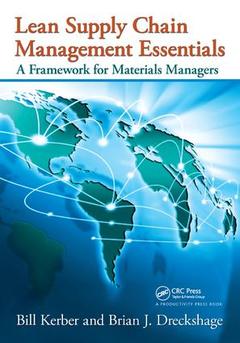Description
Lean Supply Chain Management Essentials
A Framework for Materials Managers
Authors: Kerber Bill, Dreckshage Brian J.
Language: English
Subjects for Lean Supply Chain Management Essentials:
Keywords
APICS Dictionary; Period Order Quantity; Material Planning; Lot Sizing Approach; Lean; Takt Time; Supply Chain Management; Cycle Time; Enterprise Resource Planning; Operator Balance Charts; FIFO Lane; Mix Variability; Production Schedule; Master Production Schedule; ERP System; Heijunka Schedule; Lot Sizing Rules; Kanban Card; Toyota Production System; Chase Strategy; Pull System; Shop Floor Control; Product Family; Lot Sizing; Kaizen Management; Economic Order Quantity; Variable Backlog; VMI; Lean Purchasing
284.79 €
In Print (Delivery period: 14 days).
Add to cartPublication date: 07-2017
· 17.4x24.6 cm · Hardback
85.88 €
In Print (Delivery period: 15 days).
Add to cartPublication date: 04-2011
260 p. · 17.4x24.6 cm · Paperback
Description
/li>Contents
/li>Readership
/li>Biography
/li>
Presenting an alternate approach to supply chain management, Lean Supply Chain Management Essentials: A Framework for Materials Managers explains why the traditional materials planning environment, typically embodied by an Enterprise Resource Planning (ERP) system, is an ineffective support system for a company that wants to adopt Lean practices. It begins by defining supply chain management basics, including roles, objectives, and responsibilities from a traditional framework. Next, it describes Lean basics and explores the conflicts between Lean and the traditional framework.
The book focuses on the materials management aspects of Lean, such as leveling work into the value stream, heijunka scheduling, standard work, and the concept of intervals, including Every Part Every Interval (EPEI). By combining traditional materials management tools, such as Sales and Operations Planning (SandOP), with Lean manufacturing approaches and applying them to different manufacturing environments, the authors clarify the logic behind why you are doing what you?re doing with Lean components and how they fit together as a system. Specifically, they explain how to:
Determine which leveling strategy to use to smooth production
Calculate interval to determine lot sizes in various production environments
Apply Lean to purchasing, warehouse, and logistics areas
Use your value stream map for green initiatives and risk management
Replace capacity planning and shop floor control with visual factory, operator balance charts, EPEI, and plan for every part
Illustrating why balancing demand and capacity is better than trying to balance supply and demand, the book includes a definitive chart that matches Lean tools to the planning and control charts that have served as the model for ERP systems. It integrates the principles learned from Toyota?s fift
Introduction, Chapter 1 Lean Basics, Chapter 2 Executive S&OP, Forecasting, and Customer Relationships, Chapter 3 Leveling and Heijunka, Chapter 4 Dependent Demand Materials, Chapter 5 Capacity Management and Shop Floor Control, Chapter 6 Inventory Management, Chapter 7 Lot Sizing, Chapter 8 Warehousing and Logistics, Chapter 9 Quality Control, Chapter 10 Purchasing, Chapter 11 Lean System, Appendix 1: The Myth of the Bell-Shaped Curve: Inventory Leveland Customer Service, Appendix 2: The Bullwhip Effect, Appendix 3: Lean Implementation Methodology, Appendix 4: Using Your Value Stream Map for Green Initiatives and Risk Management




